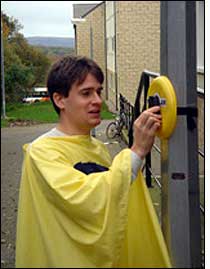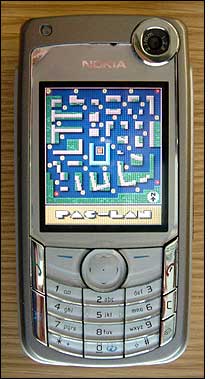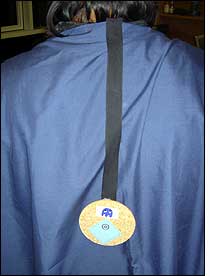A Lancaster University research group known as Mobile Radicals, and a U.K. health advisor, with funding from Royal Parks, have teamed up to develop a way to use RFID to coax an increasingly sedentary population off their couches.
The system, known as Health Buddy, employs RFID-enabled Nokia phones to track users’ movements as they walk around Hyde Park or other sections of London, then transmit the data to a Web server. Users can chronicle the distance they walk and calculate the number of calories burned. In the future, they might also earn rewards, such as coupons or financial discounts, for getting fresh air and exercise.
Health Buddy is not yet commercially available and has, to date, been used only in pilots. Its developers first intend to study the system’s benefits on users’ health habits in summer 2008, then make plans for a full-scale deployment in London or other parts of the United Kingdom. Health Buddy enables people to track their movements by tapping RFID cards against mobile phones installed in weatherproof boxes in public places. With a GPRS connection in the phone, data about the users’ movements can be transmitted to a server, which will then chronicle their activity on a Web site.
London physician William Bird, strategic health advisor for federal environmental conservation group Natural England and chair of health group Outdoor Health Forum, has been behind a series of federally funded programs designed to get British residents on their feet and outdoors. Bird has organized Health Walk, a nationwide program that has spurred 13,000 walks so far, and Green Gym, another national program that combines environment conservation with exercise.
Last year, Bird came across Pac-Lan, a game that uses NFC-enabled phones to draw video gamers outdoors. Developed by Paul Coulton, director of Lancaster University’s Mobile Applications Research Group, Pac-Lan encourages players to come away from their computer screens and play a physical game that requires exercise but, Coulton says, has all the elements of the Pac-Man videogame.
Instead of guiding a munching ball-shaped computerized character through a maze on a video screen, players must dash through the Lancaster University Campus using their mobile phones to track each other, and to tap 13.56 MHz passive RFID tags attached to plastic discs that represent “power pills” analogous to those that Pac-Man eats in the videogame. The tags contain NXP Semiconductors‘ Mifare chips, which comply with the ISO 14443 and Near Field Communication (NFC) standards.The Pac-Lan game, deployed at the university in early 2006, has been played on a temporary maze laid out at the campus. To play the game, each Pac-Lan player wears an NFC tag pendant and carries a Nokia phone with a built-in RFID interrogator. The playing field and each of the four players’ locations are displayed on the phone’s screen, using Pac-Lan game software designed by Mobile Applications. Players collect pills using their phone to tap the brightly colored RFID-enabled discs mounted on posts around the maze. Four other players take the role of the ghosts and attempt to hunt down the Pac-Lan players.
The game is controlled by a computer server running a Java application that links Pac-Lan players and the ghosts. The server relays to the Pac-Lan players their current position, and that of the ghosts, based on the pills collected. Ghosts can use the pills as well, tapping their phones within range of the RFID tags to learn the other Pac-Lan players’ last known position, based on the last time they collected a pill. The ghosts can kill a Pac-Lan player by using a mobile phone to tap the player’s pendants. Similarly, when a Pac-Lan player collects a power pill, he can then kill the ghosts using the same RFID detection process. Dead ghosts must then return to the central point to be reactivated into the game. Points are allocated based on the number of pills collected and ghosts killed.
“The idea was to play a real-world mobile game by mixing reality with cyberspace,” Coulton says. “It can help promote exercise with the fun of a video game.” Pac-Lan was developed not just to encourage exercise, he notes, but also to explore new innovative ways to use mobile phone technology, which is part of the Mobile Applications Research Group’s mission.
Bird contacted Coulton to suggest a similar system that would encourage exercise among Londoners. Bird envisioned using NFC-enabled phones in conjunction with RFID tags such as those embedded in Oyster cards, electronic transit tickets that contain an RFID inlay with a Mifare chip. The goal is to create a system that rewards Transport for London transit passengers for exercising on their way to and from work, or just making their way around the city.
In August 2007, Bird and Coulton sought the use of a Java-based system similar to Pac-Lan; in this case, however, 12 NFC-enabled Nokia phones were installed in sealed containers on posts around London’s 350-acre Hyde Park. About 30 volunteers, consisting of park staff and others who were simply interested in the project, used small plastic cards with embedded Mifare RFID tags to simulate the Oyster cards commuters would use in the envisioned program.As the participants arrived at each post, they tapped the card against the NFC-enabled phone. The phones, using Health Buddy software developed by Mobile Applications, would then transmit the unique ID number on the card, along with its own identification, via a GPRS connection from the phone to a server, which would then post the action on the CredX Web site hosted by Hyde Park’s parent agency, Royal Parks.
Upon returning home, users could log on to the site and determine exactly how much walking they did, and how many calories were burned. The trial was completed after one month. In the future, when the system is deployed once more, Coulton envisions issuing points earned from that exercise to obtain rewards such as coupons for health-club membership.
In addition, Coulton envisions Health Buddy users—who own NFC-enabled phones—attaching RFID tags supplied by the Health Buddy program and its sponsors (which have yet to be determined) in locations such as their own home, so they can log how far they travel—from their home to the Metro subway station, for instance, and again from the station to the office or other location. If an exercise class were underway at the park, he imagines, the class instructor could also have an RFID tag which participants could tap with their NFC-enabled phones, automatically recording extra points for getting more exercise.
Bird is presently seeking permission from Transport for London to post Health Buddy points at train stations themselves, and also to allow the Health Buddy data to be stored and sent directly from Oyster cards. With the cards, commuters may be encouraged to get off the train one station early and take an extra walk, which could then be logged on their portfolio.
By summer 2008, Bird hopes to launch another pilot of undetermined length on Royal Park property, also using NFC-enabled phones in sealed boxes installed on posts, with about 1,000 participants using RFID tags. NFC-enabled phones are still rare in the United Kingdom but are expected to become commonplace in the next few years. To date, about 100 people at Lancaster University—all new students to Coulton’s classes—have participated in the Pac-Lan game to test how well they like it.





